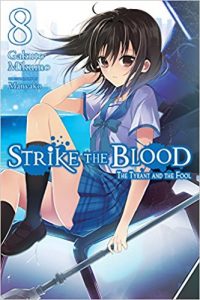By Gakuto Mikumo and Manyako. Released in Japan by Dengeki Bunko. Released in North America by Yen On. Translated by Jeremiah Bourque.
Strike the Blood remains, to the end, a very good action series and a really lousy harem series. Kojou, despite the bloody nose indicating arousal, is one of the most asexual harem leads I’ve ever read about, and frankly I have no idea how he’s going to sire the two future children that we know about. The scenes towards the end where he does some sort of weird vampire mojo thing and makes all the girls have an orgasm (not explicitly stated, but implied) made me roll my eyes. But when it’s being a Shonen Jump style series, or when it treats his cast as an extended family, it’s much, much better. This pretty much wraps up all the outstanding plotlines with the exception of “who does he end up with”, which is left vague but implied to be twelve wives. Only one of whom bothers to say the words “I love you” directly to him in this book, so nice job, Asagi, you’re the winner in my eyes.
Yeah, for those hoping the final volume would have the entire cast on the cover, or at least more than one girl, I don’t know what you were expecting. In any case, the terrorists who have been driving the final arc’s plot are here, and they want Itogami Island. Kojou, who now has vampiric blood vassals again, is the logical choice to negotiate with them, though it’s worth noting that the obvious solution as to how to stop the terrorists is in fact “destroy the island”, not good. Meanwhile, Avrova is attending an upside-down high school in the sky… which makes no sense until halfway through the book or so… and then there’s Japan, who of course have several agents working for the government on the island, who saw what I said two sentences ago and agree with me.
Without question, the best scene in the book is halfway through it, when Natsuki, Yukina and her mentor, and Koyomi head down to the keystone holding the island together to destroy it. They can evacuate everyone in time, and with no island, the terrorists lose. The trouble with this idea is that literally everyone else hates it and regards it as giving up on Kojou, so the rest of the cast go to war against them. (This includes Sayaka, who is mind controlled into fighting, but it’s implied she would have agreed.) Seeing Yukina’s anguish and frustration as she ends up fighting half of Kojou’s love interests at once could almost sum up the series. As for the rest, yes, we get the “no, sempai, this is our fight!” line, so we’re good. The Nod stuff was a bit less interesting, with apologies to Those Two Girls And Their Dragon. It also comes with an almost literal Deus Ex Machina, as the daughters from the future help to do a spell that essentially makes everyone forget who Kojou is again. Well, except his love interests, of course.
The author says this series went on much longer than expected, and I can’t say it was entirely deserved. Still, in the end, Strike the Blood was exactly what it wanted to be, an action adventure series with vampires, girls kicking ass, and the occasional “whoops I walked in on you in your underwear” harem bullshit. Who could ask for anything more?














